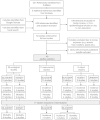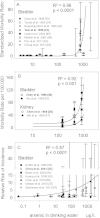Arsenic in drinking water and urinary tract cancers: a systematic review of 30 years of epidemiological evidence
- PMID: 24889821
- PMCID: PMC4088919
- DOI: 10.1186/1476-069X-13-44
Arsenic in drinking water and urinary tract cancers: a systematic review of 30 years of epidemiological evidence
Abstract
Background: Arsenic in drinking water is a public health issue affecting hundreds of millions of people worldwide. This review summarizes 30 years of epidemiological studies on arsenic exposure in drinking water and the risk of bladder or kidney cancer, quantifying these risks using a meta-analytical framework.
Methods: Forty studies met the selection criteria. Seventeen provided point estimates of arsenic concentrations in drinking water and were used in a meta-analysis of bladder cancer incidence (7 studies) and mortality (10 studies) and kidney cancer mortality (2 studies). Risk estimates for incidence and mortality were analyzed separately using Generalized Linear Models. Predicted risks for bladder cancer incidence were estimated at 10, 50 and 150 μg/L arsenic in drinking water. Bootstrap randomizations were used to assess robustness of effect size.
Results: Twenty-eight studies observed an association between arsenic in drinking water and bladder cancer. Ten studies showed an association with kidney cancer, although of lower magnitude than that for bladder cancer. The meta-analyses showed the predicted risks for bladder cancer incidence were 2.7 [1.2-4.1]; 4.2 [2.1-6.3] and; 5.8 [2.9-8.7] for drinking water arsenic levels of 10, 50, and 150 μg/L, respectively. Bootstrapped randomizations confirmed this increased risk, but, lowering the effect size to 1.4 [0.35-4.0], 2.3 [0.59-6.4], and 3.1 [0.80-8.9]. The latter suggests that with exposures to 50 μg/L, there was an 83% probability for elevated incidence of bladder cancer; and a 74% probability for elevated mortality. For both bladder and kidney cancers, mortality rates at 150 ug/L were about 30% greater than those at 10 μg/L.
Conclusion: Arsenic in drinking water is associated with an increased risk of bladder and kidney cancers, although at lower levels (<150 μg/L), there is uncertainty due to the increased likelihood of exposure misclassification at the lower end of the exposure curve. Meta-analyses suggest exposure to 10 μg/L of arsenic in drinking water may double the risk of bladder cancer, or at the very least, increase it by about 40%. With the large number of people exposed to these arsenic concentrations worldwide the public health consequences of arsenic in drinking water are substantial.
Figures




References
-
- Mandal BK, Suzuki KT. Arsenic round the world: a review. Talanta. 2002;58:201–235. - PubMed
-
- Smedley PL, Kinniburgh DG. A review of the source, behaviour and distribution of arsenic in natural waters. Appl Geochem. 2002;17:517–568.
-
- IARC. Arsenic in drinking-water. Lyon: International Agency for Research on Cancer; 2004. p. 267.
-
- Singh N, Kumar D, Sahu AP. Arsenic in the environment: effects on human health and possible prevention. J Environ Biol. 2007;28:359–365. - PubMed
Publication types
MeSH terms
Substances
Grants and funding
LinkOut - more resources
Full Text Sources
Other Literature Sources
Medical
Miscellaneous

